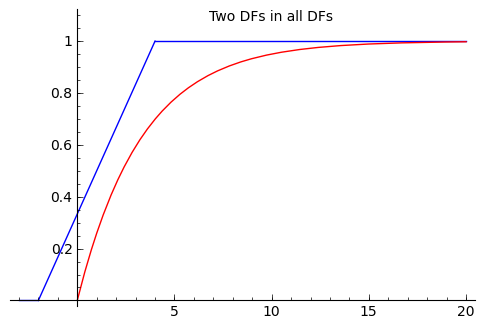Introduction to Data Science¶
1MS041, 2023¶
©2023 Raazesh Sainudiin, Benny Avelin. Attribution 4.0 International (CC BY 4.0)
Estimating the distribution function¶
Suppose we don't know what the distribution function (DF) is? We are not trying to estimate some fixed but unknown parameter $\theta^*$ for some RV we are assuming to be $Bernoulli(\theta^*)$, we are trying to estimate the DF itself. In real life, data does not come neatly labeled "I am a realisation of a $Bernoulli$ RV", or "I am a realisation of an $Exponential$ RV": an important part of inference and estimation is to make inferences about the DF itself from our observations.
Observations from some unknown process¶

Consider the following non-parametric product experiment:
$$X_1, X_2, \ldots, X_n\ \overset{IID}{\sim} F^* \in \{\text{all DFs}\}$$We want to produce a point estimate for $F^*$, which is a allowed to be any DF ("lives in the set of all DFs"), i.e., $F^* \in \{\text{all DFs}\}$
Crucially, $\{\text{all DFs}\}$, i.e., the set of all distribution functions over $\mathbb{R}$ is infinite dimensional.

We have already seen an estimate, made using the data, of a distribution function: the empirical or data-based distribution function (or empirical cumulative distribution function). This can be formalized as the following process of adding indicator functions of the half-lines beginning at the data points $[X_1,+\infty),[X_2,+\infty),\ldots,[X_n,+\infty)$:
$$\widehat{F}_n (x) = \frac{1}{n} \sum_{i=1}^n \mathbf{1}_{[X_i,+\infty)}(x)$$where,
$$\mathbf{1}_{[X_i,+\infty)}(x) := \begin{cases} & 1 \quad \text{ if } X_i \leq x \\ & 0 \quad \text{ if }X_i > x \end{cases}$$Lets take a look at this for an example
import numpy as np
X = np.random.poisson(1,size=1000)
from Utils import makeEDF, makeEMF, plotEDF
print(makeEDF(X))
plotEDF(makeEDF(X))
Dvoretsky-Kiefer-Wolfowitz (DKW) Inequality¶
Let $X_1, X_2, \ldots, X_n \overset{IID}{\sim} F^* \in \{\text{all DFs}\}$
and the empirical distribution function (EDF) is $\widehat{F}_n(x) := \displaystyle\frac{1}{n} \sum_{i=1}^n \mathbf{1}_{[X_i,+\infty)}(x)$,
then, for any $\varepsilon > 0$,
$$P\left( \sup_x { | \widehat{F}_n(x) - F^*(x) | > \varepsilon }\right) \leq 2 \exp(-2n\varepsilon^2) $$We can use this inequality to get a $1-\alpha$ confidence band $C_n(x) := \left[\underline{C}_n(x), \overline{C}_n(x)\right]$ about our point estimate $\widehat{F}_n$ of our possibly unknown $F^*$ such that the $F^*$ is 'trapped' by the band with probability at least $1-\varepsilon$.
$$ \begin{aligned} \underline{C}_{\, n}(x) &= \max \{ \widehat{F}_n(x)-\varepsilon_n, 0 \}, \notag \\ \overline{C}_{\, n}(x) &= \min \{ \widehat{F}_n(x)+\varepsilon_n, 1 \}, \notag \\ \varepsilon_n &= \sqrt{ \frac{1}{2n} \log \left( \frac{2}{\alpha}\right)} \\ \end{aligned} $$and
$$P\left(\underline{C}_n(x) \leq F^*(x) \leq \overline{C}_n(x)\right) \geq 1-\alpha$$Estimating the density¶
For a discrete random variable, estimating the density (pmf) is as simple as using the empirical pmf
from Utils import plotEMF
print(makeEMF(X))
plotEMF(makeEMF(X))
For a continuous random variable¶
For a continuous random variable we cannot really use the pmf, instead we consider something like a histogram
Y = np.random.normal(size=1000)
freq,bins,_ = plt.hist(Y,density=True,bins=50)
print(" Bin \t Freq")
for frq,l_edge,r_edge in zip(freq,bins,bins[1:]):
print("[%.2f,%.2f] \t %.2f" % (l_edge,r_edge,frq))
Whenever we want to use a histogram estimator, we need to decide how many bins we are going to need. This is a topic for another day.
Regression example of risk minimization¶
Consider the following house price data
import csv
data = []
header = []
with open('data/portland.csv', mode='r') as f:
reader = csv.reader(f)
header = tuple(next(reader))
for row in reader:
try:
data.append((int(row[0]),int(row[1]),int(row[2])))
except e:
print(e)
print(header)
print(data[:1])
Lets think that the data generator $X$ is here the size of the house and the $Y$ is the price of the house.
import numpy as np
D = np.array(data)
X = D[:,0]
Y = D[:,2]
import matplotlib.pyplot as plt
plt.scatter(X,Y)
Linear regression¶
An example of a learning machine is linear regression with quadratic loss. What we have is essentially
- The loss is the quadratic function
- We are searching among linear functions, $g_{k,m}(x) = kx+m$.
R = lambda a: np.mean(np.power((a[0]*X+a[1]-Y),2))
import scipy.optimize as so
We can use scipy to minimize the total loss $L$ above.
result = so.minimize(R,(0,0),method = 'Nelder-Mead')
result
This gives us that the found $k \approx 135$ and the found $m \approx 70000$, we can also plot this together with data to see
x_pred = np.linspace(np.min(X),np.max(X),2)
y_pred = x_pred*result['x'][0]+result['x'][1]
plt.scatter(X,Y)
plt.plot(x_pred,y_pred,color='green')